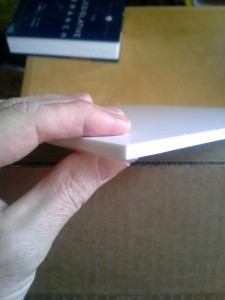
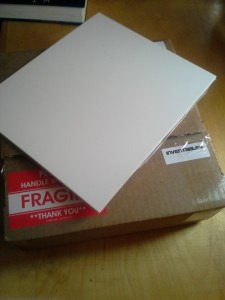 Some of the joys of living rural include having bear, moose and coyote traipse through your yard and sample your garden, send the dog into chaotic spasms of barking and howling and having neighbors farther away from you than you can throw a rock (unless you sneak up on them). The downside is unless you know what delivery service your vendor is going to use and the exact address they have for you in their database, your material can come maddeningly close to your house only to get shipped back halfway across the United States. This is what almost happened to the corian (pronounced “CORE-ian”). If you use the people in the brown trucks you need to be sure the street address starts with “S.” and not “South”. If it’s the people with the eagle on their shoulder, it’s another matter altogether. Fortunately our USPS employees are friendly and helpful, and held the package for me as I raced down to pick it up.
Some of the joys of living rural include having bear, moose and coyote traipse through your yard and sample your garden, send the dog into chaotic spasms of barking and howling and having neighbors farther away from you than you can throw a rock (unless you sneak up on them). The downside is unless you know what delivery service your vendor is going to use and the exact address they have for you in their database, your material can come maddeningly close to your house only to get shipped back halfway across the United States. This is what almost happened to the corian (pronounced “CORE-ian”). If you use the people in the brown trucks you need to be sure the street address starts with “S.” and not “South”. If it’s the people with the eagle on their shoulder, it’s another matter altogether. Fortunately our USPS employees are friendly and helpful, and held the package for me as I raced down to pick it up.
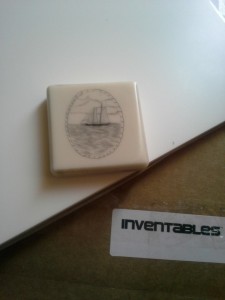
Corian is actually a mixture of acrylic and alumina trihydrate – which is refined from bauxite to a fine white powder and makes the material opaque. By adding other colorants and materials a whole host of textures can be created.
It can be difficult to get Corian in the colors you want, since you usually need to pick up a full 48″ x 96″ sheet. Instructables has black and white, though if you hunt around on eBay you can find smaller pieces from suppliers in many different colors.
As the material is acrylic with a powder in suspension, it tends to dust rather than curl even with an extremely sharp tool when you scribe. When stippling it doesn’t crater like polyester, making this technique a viable means of creating an image too. Jigsaws and “rotozip” tools cut through it well, just don’t have the speed too high or you will melt rather than cut and make a big stink.
As in previous tests, India ink appears to work the best, oil wiping out easily unless you let it set for several days to a week. Nick Finocchio regularly uses Corian, while others such as Katherine Plumer have used it on occasion.
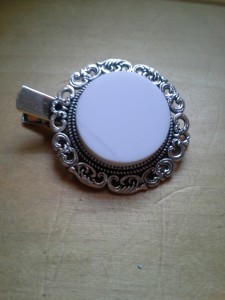 Buying two sheets from Inventables will bring the cost down to about $0.46 per square inch in the US, while if you can find ¼” sheets on eBay it can drop to $0.14 per square inch and sometimes less and in a variety of colors, patterns and more.
Buying two sheets from Inventables will bring the cost down to about $0.46 per square inch in the US, while if you can find ¼” sheets on eBay it can drop to $0.14 per square inch and sometimes less and in a variety of colors, patterns and more.
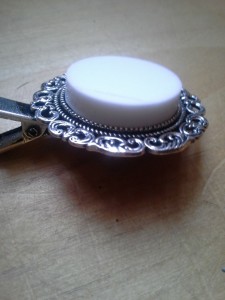 We had purchased the 1/4″ sheets in hopes of being able to cut and polish the material without much further prep work in order to use it as jewelry cabochons. As you can see in the pic, they’re a bit too thick still to be used as such, but this thickness would be perfect for domed cabs and for knife handles, as well as for display pieces, thicker inlay work and more – coasters, ornaments… any other ideas for projects with 1/4″ Corian?
We had purchased the 1/4″ sheets in hopes of being able to cut and polish the material without much further prep work in order to use it as jewelry cabochons. As you can see in the pic, they’re a bit too thick still to be used as such, but this thickness would be perfect for domed cabs and for knife handles, as well as for display pieces, thicker inlay work and more – coasters, ornaments… any other ideas for projects with 1/4″ Corian?
Update, May 2020
One downside of working with Corian or one of it’s many competitors is that it can dull your scrimshaw tool after only a few scrimshaws. I’d used one of my coveted tungsten points from Mr. Coulter aka scrimshawtoolman on Etsy.com and then went to work on a commissioned piece, only to find the point was not cutting into the galalith (my favorite alternative material), but was instead just indenting it. Comparing the point with my last unused Coulter point I found that I’d worn the fine point down just enough. Tungsten is best sharpened with a rotary diamond hone, and trying my Lansky knife sharpener on the point by hand didn’t remove a thing. Fortunately I didn’t obsess, I simply ordered more points, put the dulled points into my used supply to send back and have resharpened (yes, he’ll do this at a giveaway price), and started again. If you decide you like using Corian, I’d recommend getting a couple of sets of points along with the handle from scrimshawtoolman, or if you’re just starting out, you could get a five pack of tungsten tools (10 points total, they’re double-sided) from Amazon.com.